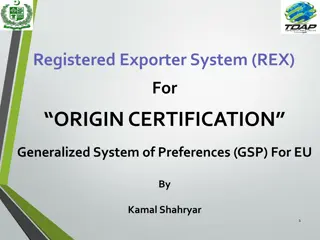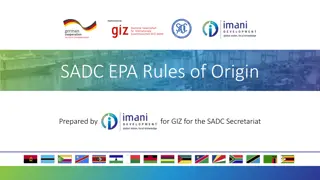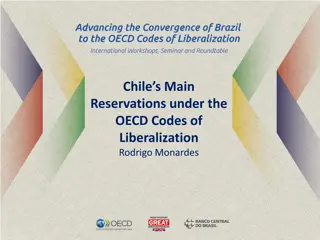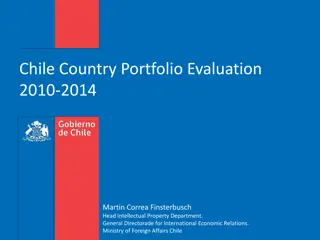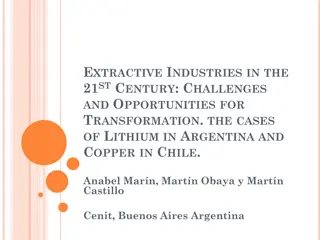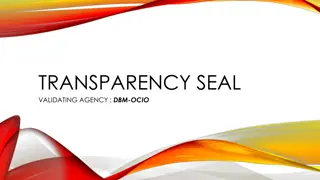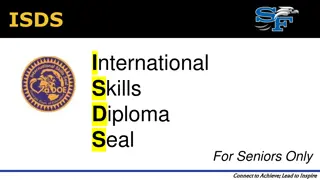The Seal of Origin Program in Chile
The Seal of Origin Program in Chile aims to add value to traditional products by emphasizing their specific geographical origins and unique qualities. It includes seals, geographical indications, appellations of origin, and certification marks to highlight the authenticity and standards of products. Challenges such as limited use of intellectual property tools, high costs of legal protection, and low associative capacity are hindering the full potential of local products.
Download Presentation

Please find below an Image/Link to download the presentation.
The content on the website is provided AS IS for your information and personal use only. It may not be sold, licensed, or shared on other websites without obtaining consent from the author.If you encounter any issues during the download, it is possible that the publisher has removed the file from their server.
You are allowed to download the files provided on this website for personal or commercial use, subject to the condition that they are used lawfully. All files are the property of their respective owners.
The content on the website is provided AS IS for your information and personal use only. It may not be sold, licensed, or shared on other websites without obtaining consent from the author.
E N D
Presentation Transcript
"Tell me the origin of the product and I ll tell you If I m interested
SELLO DE ORIGEN Seal of origin Adding value to traditional products from Chile Paola Guerrero Andreu Legal Advisor, Trademark, Geographical Indications and Appellations of Origin Division INSTITUTO NACIONAL DE PROPIEDAD INDUSTRIAL
What is the Seal of Origin program?
The Seal A Geographical Indication: is a sign to be used on goods that have a specific geographical origin and possess qualities or a reputation due to such particular According to the chilean law. place of origin. The Appellation of Origin: is a special kind of Geographical Indication which generally consists of a geographical name or a traditional designation that is used on products which have a specific quality or characteristics essentially given by environment of their production , as well as other natural and human factors that affect the characterization of the product. the geographical
The Seal The Certification marks: are distinctive signs which indicate that a determined product or service meets a set of standards and therefore have been a standard certification entity. certified by The Collective marks: are meant to identify such products and services in the market, differentiating them from those produced or provided by third parties that are not part of the corresponding association or group.
Diagnosis Pending work with local communities Limited use of IP tools Products at risk, which did not reach their potential High cost to obtain legal protection Lack of business models Low associative capacity
Diagnosis Pending work with local communities Limited use of IP tools Products at risk, which did not reach their potential High cost to obtain legal protection Lack of business models Low associative capacity
Diagnosis Pending work with local communities Limited use of IP tools Products at risk, which did not reach their potential High cost to obtain legal protection Lack of business models Low associative capacity
Diagnosis Pending work with local communities Limited use of IP tools Products at risk, which did not reach their potential High cost to obtain legal protection Lack of business models Low associative capacity
Diagnosis Pending work with local communities Limited use of IP tools Products at risk, which did not reach their potential High cost to obtain legal protection Lack of business models Low associative capacity
Diagnosis Pending work with local communities Limited use of IP tools Products at risk, which did not reach their potential High cost to obtain legal protection Lack of business models Low associative practices
Diagnosis Pending work with local communities Limited use of IP tools Products at risk, which did not reach their potential High cost to obtain legal protection Lack of business models Low associative capacity
What did we do? A working plan with different stakeholders aiming to add value to local well-known products.
Local Communities Information gathering of relevant and well-known products by region (through regional and county governments).
Limited use of IP tools Territorial work throughout Chile, jointly with local universities, to promote the use of IPR s, especially of GI, AO, and collective and certification marks.
Value and benefits of the Seal New generations of local people did not want to continue traditions since products were not providing enough incomes to subsist.
Product at risk Traditions are being lost over time. The Seal of Origin Program rescues and values the traditions and history behind each product, recognizing that each of them is not only the motor of change and workforce, but also protector of the traditions of the local communities [Embroidery from Isla Negra]
High cost to obtain legal protection Working with government agencies and private entities to provide necessary resources for technical assistance
Lack of business model Working with different Government Agencies: providing resources for education and a business model for the relevant product Ex. Agricultural Research Foundation (FIA); Production Development Corporation (CORFO), etc.
Low associative practices Local communities applying for a Seal shall associate different producers willing to be recognized by the Seal of Origin. Although it has been a difficult process to reach that goal, inclusiveness among groups of producers has been satisfactorily achieved.
What did we do? A working plan with different stakeholders aiming to add value to local well-known products. Objectives of the Seal of Origin Objectives of the Seal of Origin
Strategic objectives Identification products; of traditional Chilean Highlight local traditions; Contribute to the development of local communities; Promotion increasing the value of products, and the variety of choices for consumers; of natural resources, Strengthen traceability and monitoring of protected products; Avoid unfair competition ; Sharing and counseling of instruments protective of IP.
What did we do? A working plan with different stakeholders aiming to add value to local well-known products. in the Seal of Origin Program Life Cycle of a product
Improvement Promotion Based on established strategic pillars, and once the product has been protected Intellectual Property Rights, a life cycle of products included in the Seal of Origin program has been defined by Exportation Protection Life Cycle of a Product in the Seal of Origin Program Commercialization Recognition Dissemination
Milestones Product differentiation on the market
Milestones Benefits for obtaining governmental funding
Milestones Consumers appreciation (Fast sale of tomatoes, signs, creation of touristic routes, presence in gourmet restaurants).
Next steps Add more products to the program Product positioning abroad; Self-management; Strengthening of association among producers; Guidelines for the use of GI and AO; Seal ambassadors to be designated; Alliances with public and private actors; Assessment of the program by 2018.
Chilean products with Seal of Origin (26) Chile Chicha de Curacav and Dulces de Curacav .
SELLO DE ORIGEN Seal of origin Thank you www.sellodeorigen.cl sellodeorigen@inapi.cl INSTITUTO NACIONAL DE PROPIEDAD INDUSTRIAL





